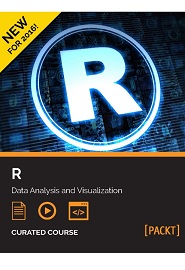
English | 2016 | ISBN: 978-1786463500 | 1783 Pages | PDF, EPUB, MOBI | 313 MB
Master the art of building analytical models using R
The R learning path created for you has five connected modules, which are a mini-course in their own right. As you complete each one, you’ll have gained key skills and be ready for the material in the next module!
This course begins by looking at the Data Analysis with R module. This will help you navigate the R environment. You’ll gain a thorough understanding of statistical reasoning and sampling. Finally, you’ll be able to put best practices into effect to make your job easier and facilitate reproducibility.
The second place to explore is R Graphs, which will help you leverage powerful default R graphics and utilize advanced graphics systems such as lattice and ggplot2, the grammar of graphics. You’ll learn how to produce, customize, and publish advanced visualizations using this popular and powerful framework.
With the third module, Learning Data Mining with R, you will learn how to manipulate data with R using code snippets and be introduced to mining frequent patterns, association, and correlations while working with R programs.
The Mastering R for Quantitative Finance module pragmatically introduces both the quantitative finance concepts and their modeling in R, enabling you to build a tailor-made trading system on your own. By the end of the module, you will be well-versed with various financial techniques using R and will be able to place good bets while making financial decisions.
Finally, we’ll look at the Machine Learning with R module. With this module, you’ll discover all the analytical tools you need to gain insights from complex data and learn how to choose the correct algorithm for your specific needs. You’ll also learn to apply machine learning methods to deal with common tasks, including classification, prediction, forecasting, and so on.
What You Will Learn
- Describe and visualize the behavior of data and relationships between data
- Gain a thorough understanding of statistical reasoning and sampling
- Handle missing data gracefully using multiple imputation
- Create diverse types of bar charts using the default R functions
- Familiarize yourself with algorithms written in R for spatial data mining, text mining, and so on
- Understand relationships between market factors and their impact on your portfolio
- Harness the power of R to build machine learning algorithms with real-world data science applications
- Learn specialized machine learning techniques for text mining, big data, and more
Resolve the captcha to access the links!